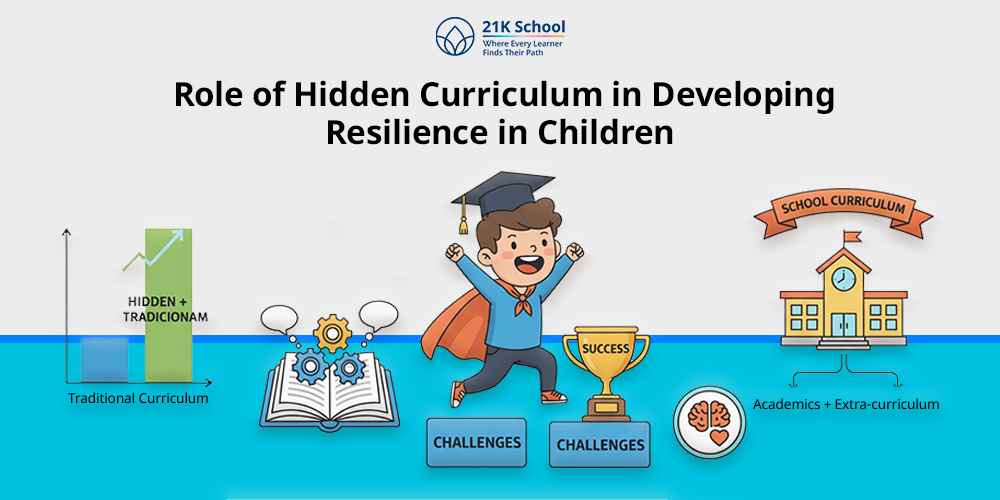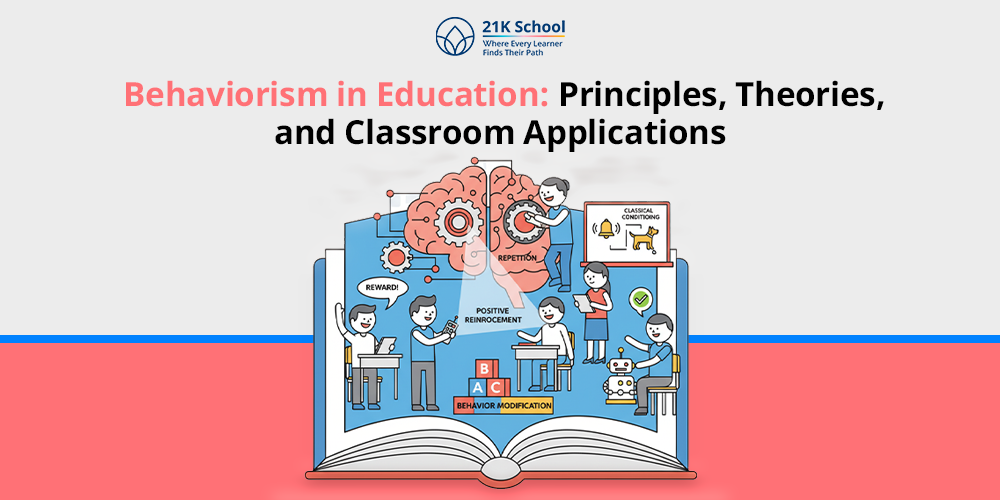
Learning beyond the textbook is equally powerful in modern education. Parents and teachers often look for the best way to improve kids’ learning.
Here, comes “Hidden Curriculum” which includes secret lessons, routines, social norms, and moral expectations helps learners to develop 21st century skills.
The role of hidden curriculum in developing resilience in children helps them to deal with challenges, adapt to change, and reattempt from setbacks.
With time the development of resilience in children through hidden curriculum improved academic performance, mental well-being, and relationship building.
Let’s understand the role of hidden curriculum in developing resilience in children.
Table of Contents
- What Is a Hidden Curriculum?
- 12 Roles of Hidden Curriculum in Developing Resilience in Children
- 1. Promotes Positive Social Interaction
- 2. Encourages Problem-Solving Skills
- 3. Fosters Emotional Regulation
- 4. Builds Adaptability and Flexibility
- 5. Instills Perseverance and Patience
- 6. Promotes Self-Efficacy and Confidence
- 7. Strengthens Empathy and Compassion
- 8. Encourages Responsibility and Accountability
- 9. Develops Respect and Tolerance
- 10. Enhances Communication and Interpersonal Skills
- 11. Encourages Self-Reflection
- 12. Cultivates a Growth Mindset
- Conclusion
What Is a Hidden Curriculum?
The hidden curriculum refers to the unwritten, informal lessons, values, and social norms students learn in school beyond the formal academic subjects.
Some common examples of hidden curriculum in students are:
- Students learn teamwork by working on projects together.
- Kids standing in a row to or wait for their turn to learn patience.
- In assembly, being chosen as a Vice Captain builds responsibility and confidence.
The hidden curriculum is a foundational element in developing resilience in students.
12 Roles of Hidden Curriculum in Developing Resilience in Children
Below are 12 important roles of hidden curriculum in the development of resilience in children by schools.
1. Promotes Positive Social Interaction
Implementation of hidden curriculum in students life promotes positive social interaction including sharing, collaborative and communication skills.
This improves peer learning students’ friendship and bond where kids learn about teamwork and leadership skills.
By building social resilience individuals can support each other.
2. Encourages Problem-Solving Skills
Learning often comes with various small to big challenges which requires problem-solving skills to resolve.
Through a hidden curriculum kids can learn how to analyse situations, look for different possibilities, and find impactful solutions.
It is an ideal way to deal with real-world challenges and become better in life.
3. Fosters Emotional Regulation
Students often deal with different kinds of emotions. The hidden curriculum fosters emotional regulation of students.
Cope with stress, anxiety, or failure in a healthy way to ensure mental and physical strength to achieve success.
This directly helps in resilience development in which students stay calm and focus on retrying even after failure.
4. Builds Adaptability and Flexibility
Adaptability is a key to skills of resilience and hidden curriculum guides learners to adjust in the positive learning environment.
It is an effective way to develop capacity to manage change. Here, kids can develop their own ways, recreate strategies, and solve problems with innovative solutions.
5. Instills Perseverance and Patience
Children must understand that success doesn’t happen overnight, it requires perseverance and patience.
From waiting to get a turn for a presentation, to practicing mathematical questions to get solutions ensures perseverance and patience.
By this way students understand the value of practice, efforts, and struggle to get desired results and growth.
6. Promotes Self-Efficacy and Confidence
To promote self-efficacy and confidence in students, hidden curriculum plays a vital role in education.
Various activities such as leading a team, managing class duties, and helping peers guide them to build trust and confidence.
It is an ideal way to learn skills without any boundaries.
7. Strengthens Empathy and Compassion
Involvement of students in different situations of school life help him to understand their emotions and how to control it.
With empathy they can make connections and support each other. A resilient kid is emotionally strong and understands other difficulties.
Comforting a peer due to less marks on class tests can be an ideal example.
8. Encourages Responsibility and Accountability
The hidden curriculum often encourages responsibility and accountability in students. By following school rules, submitting homework on time etc are ideal ways.
Taking responsibility and becoming accountable towards others are two important parts of resilience which turn failure into opportunities for growth.
9. Develops Respect and Tolerance
With hidden curriculum kids learn respect towards others and tolerate others opinion. This can be done through equality and mutual understanding.
School is a safe environment where students understand and value diverse opinions and accept without judging.
10. Enhances Communication and Interpersonal Skills
The hidden curriculum is an ideal way to promote communication skills in students. They can be involved in presentations, group discussions, and class interactions.
This allows them to explore and find out academic challenges with confidence. For example, a student learns how to handle a debate with politeness and empathy.
11. Encourages Self-Reflection
Students exploring their own behavior, emotions, and feelings in response to the implicit lessons of the school environment encourages self-reflection in them.
For development of resilience, self-awareness and reflection is important. One must believe in their own capabilities and grow from multiple failures.
12. Cultivates a Growth Mindset
By teaching resilience through modeling and implicit lessons, hidden curriculum helps kids to cultivate a growth mindset.
One simple example, if a facilitator praises students’ efforts rather than the end result, gives them confidence to try harder to achieve better.
With patience and continuous learning this can be possible.
Conclusion
The hidden curriculum in students’ lives is equally important as the formal curriculum. Schools and facilitators should take responsibility to implement effectively.
Kids are often unable to remember various chapters or concepts but a hidden curriculum helps them in retention for a longer period.
It is one of the important parts of students’ lives where they learn how to develop resilience which means bouncing back from challenging situations and adapting to stress.
It’s time to find out the right way of education and spread awareness about hidden curriculum in classroom learning.


